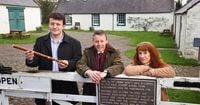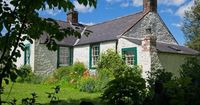On the eve of St Andrew’s Day 2025, Scotland’s cultural landscape witnessed a momentous rallying cry: the launch of a £12 million international fundraising campaign to save Ellisland Farm, the historic Dumfriesshire home where Robert Burns wrote “Auld Lang Syne” and more than a quarter of his life’s work. The “Saving the Home of Auld Lang Syne” campaign, spearheaded by The Robert Burns Ellisland Trust, aims not just to restore a crumbling farmhouse but to transform it into a world-class heritage destination that bridges the poet’s enduring legacy with the creative spirit of today.
The campaign’s ambitions are as bold as they are heartfelt. Organizers hope to safeguard a nationally significant collection, revive the only home ever built by Burns himself, and create a vibrant cultural hub that attracts visitors from across the globe. According to The Herald, the campaign’s official launch event took place at Collective Architecture’s Glasgow studio, where the premiere of a specially commissioned film—produced by Edinburgh filmmakers Stroma—set the tone. The film featured Scotland’s national Makar, Peter Mackay, and Lorna Goodison, the former Poet Laureate of Jamaica, both of whom recently completed residencies at Ellisland, underscoring the site’s international resonance.
Duncan Dornan, chair of The Robert Burns Ellisland Trust and a veteran of the £68 million Burrell Renaissance, spoke passionately about the project’s potential. “Tonight marks the beginning of an ambitious campaign to secure the future of a site of international cultural significance. Having led the Burrell Renaissance, I know what can be achieved when vision meets determination and commitment. Ellisland has that same potential to become both a national landmark and a source of enduring inspiration. This is our opportunity to preserve the home where the world’s most famous song was born and ensure it thrives for generations to come,” Dornan told attendees, according to BBC News.
Ellisland Farm’s history is as rich as its present is precarious. Burns took up the lease at Whitsun in 1788, moving his wife Jean Armour and their young son to the farm that December. Two more sons were born at Ellisland, where the poet, then in his late twenties, sought a quieter domestic life after his meteoric rise to fame. The farm, which Burns described as “the poet’s choice,” became the birthplace of not only “Auld Lang Syne” but also “Tam o’ Shanter,” “My Heart’s in the Highlands,” and “Banks and Braes.”
Yet time has not been kind to Ellisland. The Category A listed building—designed and built by Burns himself—has suffered decades of damp, decay, and structural deterioration. A 2021 conservation study, funded by Historic Environment Scotland, confirmed the urgent need for extensive repairs, finding that the buildings could no longer safely house the museum’s collection. The Trust, formed in 2020, has since made significant strides: securing official museum accreditation in 2023, recreating the site in Minecraft to engage new audiences, developing holiday accommodation to generate income, and restoring the “Burns Family Flute.” Funding from The National Lottery Heritage Fund, South of Scotland Enterprise, Museums Galleries Scotland, The Architectural Heritage Fund, and the Holywood Trust has laid the groundwork for restoration plans.
Joan McAlpine, former MSP for South Scotland and Project Director since 2021, has been instrumental in shaping the vision for Ellisland’s future. “This campaign is about reconnecting people with the landscape and creativity that shaped Burns’s greatest works. Over the past few years, we’ve undertaken extensive research and consultation to understand what Ellisland needs structurally, and to explore what it could become. It quickly became clear to us that we had to find a way to also make the site sustainable—generating income to support the heritage and culture. This site has immense potential as both a cultural destination and an engine for regional economic regeneration,” McAlpine explained during the launch, as reported by The Herald.
Indeed, the economic and cultural stakes are high. The Trust’s plans, detailed in The Herald and BBC News, envision a revived Ellisland that supports 65 local jobs annually, attracts about 17,000 visits each year, and injects approximately £576,000 annually into the local economy through community wealth building. The construction phase alone is expected to support 40 year-long jobs and add £2.8 million to local spending, with ongoing operations generating £1.5 million per year for Dumfries and Galloway. The project also aims to recreate the farmhouse as Burns and Jean knew it, drawing on newly discovered material from the Rosebery family’s “Barnbougle Papers”—including 1788 shopping lists for everything from furniture to seeds for the kitchen garden.
Architectural plans, currently in the hands of Glasgow-based Collective Architecture, are set to be revealed on Burns Night 2026. They include not just the restoration of the farmhouse but the reimagining of the original byre and threshing barn as a Centre for Song, eco-friendly hermitages for artists and visitors, and a dedicated museum space. The goal is to create a living, breathing tribute to Burns’s creativity while providing sustainable opportunities for the local community.
International engagement is also a key pillar of the campaign. According to The Herald, the Trust is collaborating with the American Scottish Foundation to connect with the Scottish diaspora through Tartan Week events in early 2026 and digital campaigns targeting Burns enthusiasts worldwide. The hope is to draw global support for a site that, while deeply rooted in Scottish soil, has shaped cultures far beyond its borders—none more so than in the United States, where “Auld Lang Syne” became synonymous with New Year’s Eve in the early 20th century.
The campaign’s launch event was more than just speeches and plans—it was a celebration of the living legacy of Burns. The evening featured music and song led by acclaimed vocalist Robyn Stapleton, an Ellisland ambassador, and the first public playing of the recently restored flute belonging to Burns’s son. Gerard Carruthers, Francis Hutcheson Professor of Scottish Literature at the University of Glasgow and a leading Burns scholar, contributed to the film and addressed the audience, further underscoring the scholarly and cultural importance of the project.
The Trust’s vision extends beyond preservation. They plan to recreate the farm as it was in Burns’s time, establish a Centre for Song, offer visitor accommodation, and provide artist residencies in eco-friendly hermitages. These efforts are expected to support dozens of jobs and bring in thousands of visitors annually, ensuring that Ellisland remains not just a monument to the past but a beacon for future creativity.
As the world prepares to sing “Auld Lang Syne” once again this coming Hogmanay, few may realize that the song’s origins lie on the banks of the River Nith at a farm built by Scotland’s national bard. Thanks to the determination of campaigners, the vision of the Ellisland Trust, and the support of Burns enthusiasts worldwide, the home of “Auld Lang Syne” may yet be saved for generations to come.


